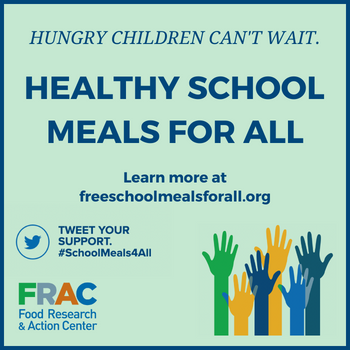
State CEP Fact Sheets By Congressional District 2025
Congress must act now to repeal SNAP cuts and invest in CEP. Find the impact of CEP in your state in FRAC’s State CEP Fact Sheets by Congressional District.
The Community Eligibility Provision (CEP) allows high-poverty schools and districts to provide breakfast and lunch at no charge to all students. Community eligibility reduces administrative paperwork; increases school meal participation; eliminates stigma; and makes it easier to implement innovative breakfast models. Community eligibility is a win for everyone — administrators, students, families, and school nutrition staff.
Quick Facts from FRAC’s Community Eligibility Report
Participation in community eligibility has grown each year as more schools learn about its many benefits. In the 2024-2025 school year:
- 54,234 schools in 8,872 school districts participated.
- 27.2 million children attended community eligibility schools.
- 74 percent of eligible schools adopted community eligibility.
Still, many eligible schools have not yet implemented community eligibility and should consider it for the coming school year.
For questions regarding Community Eligibility or FRAC’s Community Eligibility Database, please contact Erin Hysom at EHysom@frac.org.
- What is Community Eligibility, and how does it work?Community eligibility allows high-need schools to offer breakfast and lunch to all students at no charge. Any school district, group of schools in a district, or school with 25 percent or more “identified students” – children who are certified eligible for free school meals without a household application – can choose to participate.
Identified students include children directly certified through data-matching because their households receive the Supplemental Nutrition Assistance Program (SNAP), Temporary Assistance for Needy Families (TANF), or the Food Distribution Program for Indian Reservations (FDPIR), and in most states, Medicaid benefits, as well as children who are certified for free meals without an application because they are unhoused, migrant, enrolled in Head Start, or in foster care.
- Benefits of Community Eligibility
- Less administrative work—schools no longer have to collect and verify school meal applications.
- Increased Participation— schools participating in community eligibility found a 6.8 percent increase in school lunch participation and a 12.1 percent increase in school breakfast participation in the first year of implementation, according to a recent U.S. Department of Agriculture (USDA) community eligibility study on school year 2016–2017.
- Facilitates implementation of innovative breakfast service models—since schools don’t have to collect school meal fees or count each meal served by fee category, it is easier to implement of breakfast in the classroom and “grab and go” service models that can boost breakfast participation further.
- Improves the financial viability of school nutrition programs—when participation increases, school districts can take advantage of economies of scale, and reinvest any additional revenue back into the program, such as focusing on menu quality or staff training.
- Eliminates unpaid meal fees—when all children eat at no charge, the school district does not have to collect unpaid fees from families.
- Making Community Eligibility a Reality for Your DistrictFederal reimbursement for meals served in community eligibility schools is based on the school, group of schools, or district’s Identified Student Percentage (ISP). The ISP is multiplied by 1.6 to determine the percent of meals reimbursed at the free rate. The remaining meals are reimbursed at the paid rate. For example, schools with an ISP of 50 percent will have 80 percent of their breakfasts and lunches reimbursed at the free rate, and 20 percent at the paid rate. Those with an ISP of 62.5 percent or higher will receive the free rate for 100 percent of their meals served.
Thousands of schools across the country with an ISP below 62.5 have implemented community eligibility successfully. The following resources help school districts determine if community eligibility is a viable option for them.
- Strategies for Handling the Loss of School Meals Applications / Implications for Eliminating School Meal ApplicationsSometimes, the data collected via a school meals application is used to allocate education funding or determine eligibility for other programs and services. A number of resources have been developed to address the loss of school meals applications to support community eligibility implementation, such as:
- Understanding the Relationship Between Community Eligibility and Title I Funding
- Summary of State Education Funding Policies (pdf)
- The Community Eligibility Provision: Alternatives to School Meal Applications
- US Department of Education Title I Guidance for Community Eligibility Schools
- Federal Communications Commission E-Rate Guidance for Community Eligibility Schools
- Community Eligibility Outreach ResourcesFRAC’s resources can help advocates get the word out to districts and parents about the benefits of community eligibility.
- Medicaid Direct Certification Demonstration ProjectThe Healthy, Hunger-Free Kids Act of 2010 authorized demonstration projects to use Medicaid paired with household income data for direct certification. The statute requires that students be enrolled in Medicaid and belong to a family whose income, as defined by Medicaid, is below 133 percent of the federal poverty level to use Medicaid data to directly certify a student to receive free school meals.
In 2024, USDA approved 6 states to begin Medicaid Direct Certification in the 2024-2025 school year, bringing the total number of states participating in the demonstration project to 44.
Applications for states to participate in the Medicaid Direct Certification Demonstration Project are open and ongoing. The Food Research & Action Center strongly encourages states to apply so they can benefit from the demonstration project’s positive impact on children, families, and schools. Learn more here:
Resources
FRAC’s Community Eligibility Grouping Tool and Financial Calculators
Grouping Tool– Group schools together to increase your ISP and maximize your claiming percentages.
- Break Even Calculator—Use your ISP and basic information about your school nutrition operations to calculate the participation needed (in breakfast, lunch, supper and/or snack) to break even.
- District Level Calculator- Dig deeper to look at expenses and revenue under community eligibility by school type and compare implementing community eligibility to your current operations.
- To find out which schools and districts participate and qualify for community eligibility in your area, see FRAC’s Community Eligibility Database.


